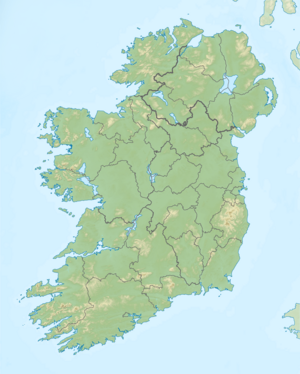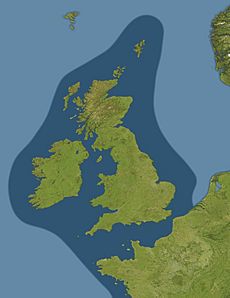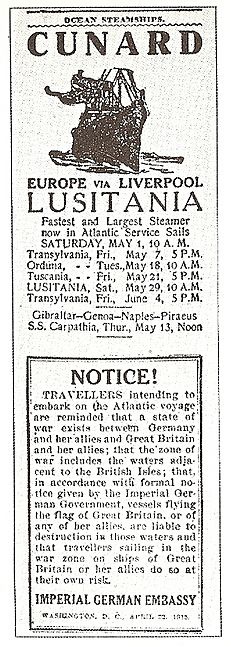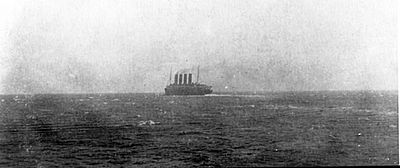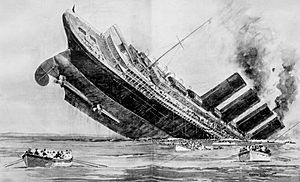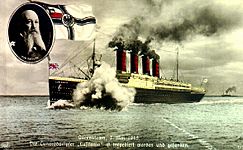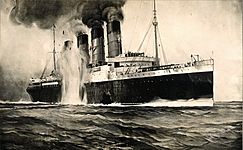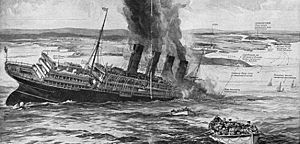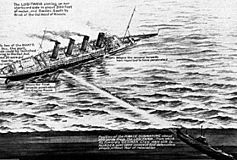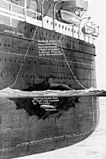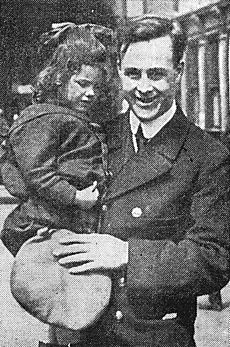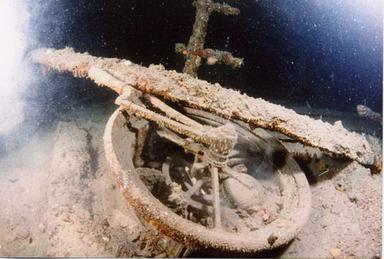Sinking of the RMS Lusitania facts for kids
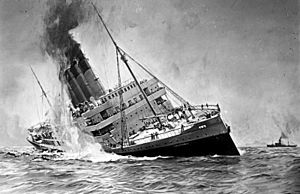
Painting of the sinking, from the German Federal Archives
|
|
| Date | 7 May 1915 |
|---|---|
| Time | 14:10 – 14:28 |
| Location | North Atlantic Ocean, near Old Head of Kinsale, Ireland |
| Coordinates | 51°25′N 8°33′W / 51.417°N 8.550°W |
| Cause | Torpedoed by German U-boat U-20 |
| Outcome |
|
The RMS Lusitania was a large British ocean liner. It was sunk by a German submarine (called a U-boat) during World War I. This happened on May 7, 1915. The ship was about 11 miles (18 km) off the coast of Old Head of Kinsale, Ireland.
Germany had announced that it would sink ships in the waters around the United Kingdom. This was part of a new strategy called unrestricted submarine warfare. It was a response to the Allies (like Britain) blocking German ports. Passengers on the Lusitania had been warned about the danger before they left New York.
The German U-boat, named U-20, was commanded by Walther Schwieger. A single torpedo hit the ship. Then, a second, larger explosion happened inside the Lusitania. The ship sank very quickly, in just 18 minutes. Out of 1,959 people on board, 1,198 died. This included 128 American citizens. The sinking made many countries angry at Germany. It also helped convince the United States to join the war two years later. Pictures of the sinking ship were used in American propaganda to encourage people to join the military.
After the sinking, both British and American investigations tried to find out exactly what happened. But wartime secrecy and propaganda made it hard to get the full truth. The Lusitania was carrying a large amount of ammunition. This led to arguments about whether the ship was a fair military target. Divers have explored the wreck since then and found military ammunition.
Contents
What Was the Lusitania?
When the Lusitania was built, the British government helped pay for it. They had a special agreement. The ship could be used as an armed warship if needed. At the start of World War I, the British Navy thought about using it this way. The Lusitania was even put on a list of ships that could become armed cruisers.
However, the Navy changed its mind. Big ships like the Lusitania used a lot of coal. They would use up too much of the Navy's fuel. So, smaller ships were used as transports instead. Still, the Lusitania stayed on the official list of armed cruisers. It was even listed as an auxiliary cruiser in a 1914 book about warships.
When the war began, people worried about the safety of large liners like the Lusitania. At first, the ship was painted a dull grey. This was to make it harder for enemy ships to spot. But then, the German Navy seemed to be under control. So, the Atlantic Ocean appeared safe for ships like the Lusitania.
Many large liners stopped sailing in late 1914 and early 1915. This was partly because fewer people were traveling. It was also to protect them from mines or other dangers. Some of these ships became troop transports or hospital ships. But the Lusitania kept sailing its regular route. To save money, one of its four boiler rooms was shut down. This lowered its top speed from over 25 knots to about 22 knots. Even so, it was still the fastest passenger ship in commercial service.
Since the dangers seemed to disappear, the Lusitania was repainted in its normal bright colors. Its name was in gold, and its funnels were painted in the usual Cunard colors.
The War Zone in 1915
In August 1914, Britain started a naval blockade against Germany. This meant they tried to stop goods, even food, from reaching Germany. In November 1914, Britain declared the North Sea a war zone. Any ships entering it did so at their own risk.
By early 1915, German U-boats (submarines) became a new threat. At first, they mainly attacked warships. But then, Germany decided to increase its submarine attacks. On February 4, 1915, Germany declared the seas around the British Isles a war zone. From February 18, Allied ships in this area would be sunk without warning. This was a very serious change.
The Lusitania was supposed to arrive in Liverpool on March 6, 1915. The British Navy gave it special instructions to avoid submarines. Even though they were short on destroyers, two warships were ordered to escort the Lusitania. However, the Lusitania's captain, Daniel Dow, refused to share his exact location by radio unless it was in a secret code. He continued to Liverpool without an escort.
Because of the new submarine threat, some changes were made to the Lusitania. It was told not to fly any flags in the war zone. Warnings and advice were sent to the captain. The ship's funnels were likely painted dark grey to make them less visible. But its famous shape meant its identity could not be hidden.
Captain Dow, feeling stressed from sailing in the war zone, left the ship. He was replaced by Captain William Thomas Turner. Captain Turner had commanded the Lusitania before the war.
On April 17, 1915, the Lusitania left Liverpool for New York. It arrived on April 24. A group of German-Americans worried about the ship being attacked. The German Embassy decided to warn passengers. On April 22, they placed a warning advertisement in 50 American newspapers. It was printed next to the Lusitania's advertisement for its return trip. The warning caused some worry among passengers and crew.
The Final Journey
Leaving New York
Many British passenger ships were used for the war. But the Lusitania kept its regular route between Liverpool and New York City. It left New York on May 1, 1915, heading back to Liverpool. There were 1,959 people on board. This included 694 crew members and 1,265 passengers. Most passengers were British, with many Canadians and 159 Americans.
Captain Turner was back in command. He was a very experienced sailor. He tried to calm passengers by saying the ship's speed would keep it safe. However, Cunard (the ship's owner) had shut down one boiler room to save money. This lowered the ship's top speed from 25.5 knots to about 22 knots.
The Lusitania left New York at noon on May 1. It was two hours late. This was because 41 passengers and crew from another ship were transferred at the last minute. Soon after leaving, three German-speaking men were found hiding on board. A detective questioned them and locked them up. They were likely spies.
Submarine Activity
As the Lusitania sailed, the British Navy was tracking the German U-boat U-20. They used secret radio intercepts to follow its movements. The submarine left Germany on April 30. It sailed around Scotland and Ireland, entering the Irish Sea. The British Navy knew where the U-boat was going. But this information was kept very secret. Only the highest officers saw it.
On March 27, the British Navy learned that Germany had broken their secret code. This code was used to send messages to British merchant ships. So, warnings sent in this code could also help enemy submarines. However, the port of Queenstown (now Cobh) kept using the old code.
On May 5, U-20 stopped a merchant ship. It allowed the crew to leave, then sank the ship. On May 6, U-20 fired a torpedo at another British ship, but missed. It then sank two more British cargo ships.

On May 5, the British Navy sent a warning to all ships: "Submarines active off the south coast of Ireland." Captain Turner of the Lusitania received this warning twice on the evening of May 6. He took what he thought were careful steps.
Around 11:00 AM on May 7, the Navy sent another warning. It said U-boats were active in the southern Irish Channel. Captain Turner changed his course. He thought it would be safer closer to land. But this report was about events from the day before. At 1:00 PM, another message came. It was inaccurate but made it seem like at least one submarine had been passed safely.
U-20 was low on fuel and had only three torpedoes left. On the morning of May 7, visibility was poor. The commander, Schwieger, decided to head home. He submerged at 11:00 AM after seeing a fishing boat. He thought it might be a British patrol. Soon after, a fast ship passed over him while he was submerged. This was a British cruiser.
The Sinking
On the morning of May 6, the Lusitania was 750 miles (1,200 km) west of southern Ireland. By 5:00 AM on May 7, it was 120 miles (190 km) west-southwest of Fastnet Rock. Heavy fog arrived, so extra lookouts were posted. Captain Turner ordered 22 lifeboats to be swung out. This was a precaution to launch them faster. As the ship neared Ireland, Captain Turner ordered speed to be reduced. He also ordered the foghorn to be sounded. Some passengers were worried that the ship was making its presence known. By 10:00 AM, the fog lifted. By noon, it was bright and sunny. The ship's speed increased to 18 knots.
U-20 surfaced again at 12:45 PM. Visibility was excellent. At 1:20 PM, Schwieger saw something. It looked like several ships at first, but then it became clear it was one large steamer. At 1:25 PM, the submarine submerged to periscope depth. It set a course to intercept the liner. When the ships were 2 miles (3 km) apart, the Lusitania turned away. Schwieger thought he had lost his target. But then, the Lusitania turned again. This time, it was on a perfect course for an attack. At 2:10 PM, with the target 700 meters away, he fired one torpedo.
In Schwieger's own words from the U-20's logbook:
Torpedo hits starboard side right behind the bridge. An unusually heavy detonation takes place with a very strong explosive cloud. The explosion of the torpedo must have been followed by a second one... The ship stops immediately and heels over to starboard very quickly, immersing simultaneously at the bow... the name Lusitania becomes visible in golden letters.
The torpedo officer also felt the explosion was very strong. Within six minutes, the Lusitania's front part began to sink.
On board the Lusitania, a lookout named Leslie Morton saw thin lines of foam. He shouted, "Torpedoes coming on the starboard side!" The torpedo hit the ship behind the bridge. A huge plume of water shot up. It knocked a lifeboat off its hooks. A second, more powerful explosion followed. Thick grey smoke poured from the funnels. Schwieger's log says he fired only one torpedo. Some people doubted this, but other crew members confirmed it.
-
German drawing of Lusitania being torpedoed which incorrectly depicts the torpedo hitting the port side of ship
-
Lusitania is shown sinking as Irish fishermen race to the rescue. In fact, the launching of the lifeboats was more chaotic
At 2:12 PM, Captain Turner ordered the ship to steer towards the Irish coast. But the ship could not be steered. Turner signaled for the engines to reverse, but it was too late. Steam pressure had dropped, so the ship could not be controlled. The Lusitania's wireless operator sent an immediate SOS message. He gave the ship's position: 10 miles (16 km) south of the Old Head of Kinsale. At 2:14 PM, electrical power failed. The ship's interior became dark. Radio signals continued on emergency batteries. But electric lifts stopped, trapping some crew members.
About one minute after power failed, Captain Turner ordered to abandon ship. Water had flooded the ship's right side. This caused the ship to tilt 15 degrees to the right.
The Lusitania's severe tilt made it hard to launch lifeboats. Ten minutes after the torpedo hit, the ship had slowed enough. But the lifeboats on the right side swung out too far. It was still possible to board lifeboats on the left side. However, lowering them was difficult. The ship's metal plates had rivets (metal fasteners). As lifeboats were lowered, they scraped against these rivets. This could damage or flip the boats.
Many lifeboats overturned while being loaded or lowered. Passengers fell into the sea. Some boats were overturned by the ship's movement when they hit the water. The Lusitania had 48 lifeboats, enough for everyone. But only 6 were successfully lowered, all from the right side. Some lifeboats that overturned later picked up people from the water. A few collapsible lifeboats floated off the decks as the ship sank. They provided flotation for some survivors.
Two lifeboats on the left side also got away. One filled with water and sank. Another floated away after people removed a rope. They rowed away just before the ship sank.
There was panic on the right side of the deck. Schwieger watched this through his periscope. By 2:25 PM, he lowered the periscope and headed out to sea. Schwieger was later killed in action in 1917 when his submarine hit a British mine.
However, surviving passengers on the left side of the deck described a calmer scene. Some said a few passengers got into lifeboats early. But they were ordered out by an officer. He said, "This ship will not sink" and that it had "touched bottom." In reality, he had ordered the crew to fill the ship's left-side ballast tanks with seawater. This was to even out the ship's tilt so lifeboats could be lowered safely. As a result, few boats on the left side were launched.
Captain Turner was on deck near the bridge. A wave swept him overboard into the sea. He found a floating chair and held onto it. He survived after being pulled from the water three hours later. The Lusitanias bow hit the bottom about 100 meters (328 ft) down. Some boilers exploded as it sank. The ship traveled about 2 miles (3 km) from the torpedoing to its final resting place. It left a trail of debris and people behind. After its bow sank, the Lusitanias stern (back) rose out of the water. Then it went under. As the tips of its four tall funnels disappeared, they created whirlpools. These pulled nearby swimmers down with the ship. Its masts were the last to disappear.
The Lusitania sank in only 18 minutes. It was 11.5 miles (18.5 km) off the Old Head of Kinsale. Even though it was close to shore, it took several hours for help to arrive. By then, many people in the cold 52°F (11°C) water had died from the cold. By the end of the day, 764 people were rescued. They were taken to Queenstown. The total number of deaths was 1,199 out of 1,959 people.
Two days before, U-20 had sunk another ship. But it allowed the crew to escape first. According to international law, a military ship stopping an unarmed civilian ship had to let people escape. But this rule was made before submarines existed. A submarine faced great risk if it gave up the advantage of a surprise attack. Schwieger could have let the Lusitania's crew and passengers escape. But he worried about being rammed or fired upon by deck guns. Merchant ships had been told to steer directly at any U-boat that surfaced.
There was a rumor that Lieutenant Schwieger's quartermaster, Charles Voegele, refused to fire the torpedo. The story said he was court-martialed and imprisoned for it. This rumor started in 1972. But accounts from other U-20 crew members do not support it.
Last Survivors
The last survivor of the Lusitania was Audrey Warren Lawson-Johnston. She was born in New York City on February 15, 1915. She was only three months old when she boarded the Lusitania with her parents and siblings. She had no memory of the disaster because she was so young. She and her five-year-old brother, Stuart, were saved by their nursemaid, Alice Maud Lines. Alice jumped off the ship and escaped in a lifeboat. Audrey's parents also survived. But her sisters Amy (age 3) and Susan (age 14 months) died. Audrey Lawson-Johnston died on January 11, 2011, just before her 96th birthday.
The last American survivor was Barbara McDermott. She was born in Connecticut on June 15, 1912. She was almost three years old when the ship sank. Her father worked in an ammunition factory and could not travel with them. Barbara remembered being in the dining room when the torpedo hit. She saw people running around the damaged ship. In the chaos, Barbara was separated from her mother. She was put into Lifeboat No. 15. Barbara later learned her mother fell into the sea but was rescued. She was placed in the same lifeboat as her daughter. Neither Barbara nor her mother was seriously hurt. Barbara died on April 12, 2008, in Wallingford, Connecticut, at age 95.
How the Lusitania is Remembered
Films and Documentaries
There is no actual video footage of the sinking.
- An early animation film, The Sinking of the Lusitania (1918), was made about the disaster. It was 12 minutes long, making it the longest animated film at that time.
- The docudrama Sinking of the Lusitania: Terror at Sea (2007) shows the Lusitania's last trip. It also explores the political and military decisions that led to the sinking.
- The National Geographic documentary Dark Secrets of the Lusitania (2012) describes an expedition to explore the wreck.
Wreck Artifacts and Museums
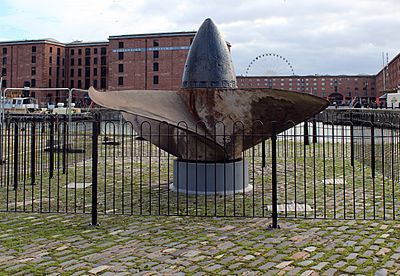
- The Merseyside Maritime Museum in Liverpool, England, has a large exhibit about the Lusitania. Liverpool was the ship's home port. In 1982, one of the ship's four propellers was brought up from the wreck. It is now on display at the Albert Dock.
- Another propeller from the wreck is on display at the Hilton Anatole hotel in Dallas, Texas.
- A lifeboat davit (a crane-like device for lowering boats) and other items are displayed at the Lusitania Museum & Old Head Signal Tower in Ireland.
- The original model of the Lusitania is displayed at the Maritime Museum of the Atlantic in Halifax, Nova Scotia. After the sinking, it was repainted to look like another ship, the RMS Mauretania.
Books and Stories
- The sinking of the Lusitania is the starting point for Agatha Christie's 1922 novel The Secret Adversary.
- Erik Larson's non-fiction book, Dead Wake: The Last Crossing of the Lusitania (2015), tells the story of the ship's final voyage from many different viewpoints.
- H.P. Lovecraft's first published book was a poem about the sinking called The Crime of Crimes: Lusitania 1915.
- The sinking inspired Michael Morpurgo's novel Listen to the Moon (2014).
- Nora Roberts' novel Three Fates (2002) begins with the Lusitania sinking.
Music
- English composer Frank Bridge wrote a piece called Lament (for Catherine, aged 9 "Lusitania" 1915) in 1915. It was a memorial to the sinking of the ship.
- Charles Ives's Orchestral Set No. 2 has a movement about the sinking. It describes Ives waiting for a train in New York City when the news of the Lusitania sinking arrived. People on the platform began singing a hymn.
- A popular song, "As the Lusitania Went Down" (1915), was published shortly after the disaster.
- Another song, "When the Lusitania Went Down" (1915), was also published.
The Wreck Site Today
The wreck of the Lusitania lies on its right side. It is about 305 feet (93 meters) underwater. The ship is badly damaged on its right side. This is because of the force with which it hit the seabed. Over many years, the Lusitania has decayed much faster than the Titanic. This is due to corrosion from the winter tides.
Some parts of the Lusitania are still visible. These include its name, some bollards (posts for tying ropes) with ropes still attached, parts of the promenade deck, some portholes, and the front (prow). Recent dives to the wreck show that the Lusitania is in surprisingly poor condition. Its hull has already started to collapse.
|
See also
 In Spanish: Hundimiento del RMS Lusitania para niños
In Spanish: Hundimiento del RMS Lusitania para niños


